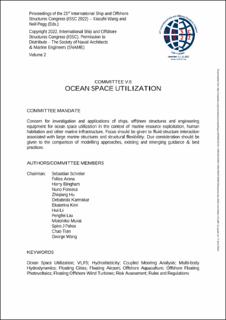| dc.description.abstract | In the light of rising sea level, scarcity of land-based resources and increasingly populated coastal areas, interest of project developers and countries turns towards the ocean, exploring the possibilities of utilizing this space for various purposes. With the oceans covering roughly 70% of the Earth’s surface and more than half of the world’s population clustered in coastal areas, the oceans are a natural direction to turn to.
Ocean Space Utilization (OSU), i.e., the use of ocean waters and/or the seabed for human activities, is by no means new. Shipping and fishing in ocean waters date back millennia. During the last century, aquaculture of seafood production developed into a global industry. Also, the seabed has provided minerals (mostly sand) as building material. Recently, the marine mining industry experienced a development from traditional sand dredging to deep sea mining for precious or rare mineral resources. The offshore oil and gas industry developed from first wooden platforms in the shallow coastal waters of the Gulf of Mexico to Floating Production Storage and Offloading systems and subsea equipment in more than 2000 m water depth offshore Brazil. More recently, the wind energy industry followed the steps of the oil and gas industry and moved from land-based installations first to shallow coastal waters with bottom-founded wind turbines and now starts developing offshore floating wind turbines for larger water depth and greater distances to shore. Marine Renewable Energies (MRE) including Wave Energy Converters (WEC), flow turbines for electricity production from ocean or tidal currents, and Ocean Thermal Energy Conversion (OTEC) are emerging. Another recent form of renewable energy production on the ocean are Offshore Floating Photovoltaic (OFPV) Installations (Karpouzoglou et al., 2020; Trapani & Millar, 2016; Trapani & Redón Santafé, 2015). Furthermore, marine infrastructure projects of floating airports (Suzuki, 2005), floating bridges and submerged tunnels (Moan & Eidem, 2020; Watanabe et al., 2015), floating oil storage terminals (Ueda, 2015; Zhang et al., 2020), floating logistics hubs/ports (Waals et al., 2018), a floating event stage (Koh and Lim, 2015), as well as even entire floating cities (Callebaut, 2015) are discussed in the literature. Eventually, recreational use and ocean research also belong to the broad field of Ocean Space Utilization.
As an inventory of Ocean Space Utilization projects, this committee gathered as many OSU projects as possible in various stages (from concept study to commercial project) and from various fields in a project atlas based on Google maps. Offshore oil and gas projects are excluded from the atlas to prevent overloading it. Figure 1.1 shows a screenshot of the project atlas with a global overview of all projects. The projects can be grouped and color-coded by OSU field or by project status as shown in the two columns on the right of the figure. At the time of writing, this project atlas contained 235 projects. Even without offshore oil and gas projects, the energy field, comprising mainly offshore wind farms, dominates the list with 90 projects. Two other large fields of OSU are food production, i.e., mainly (offshore) aquaculture with 46 projects, and infrastructure projects (35) like floating bridges and airports. From the project list by field, it is apparent that there are many projects associated with more than one field. This signifies the new trend of multi-use ocean space utilization. An example for this multi-use is mussel farming within an offshore wind farm (see Edulis project in food & energy field). Regarding the project stage, the project entries range from mere concepts and research projects to fully operational structures. The database behind this project atlas contains more information on the individual projects with details on the field (use), project name and location, coordinates, the associated institution as well as a link for further information. | en_US |
